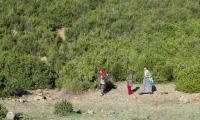PESHAWAR: The principal engineer of the Bus Rapid Transit (BRT) in his detailed rejoinder has termed as invalid and half-cooked the Provincial Inspection Team report and recommendations about the metro bus project.
Gul Hameed Khalil, the principal engineer of Peshawar Sustainable Bus Rapid Transit Project, in his 11-page “Response to Provincial Inspection Team, Khyber Pakhtunkhwa observation report pertaining to BRT Peshawar” explained each and every expect of the BRT project.
He argued that the Provincial Inspection Team (PIT) was ignorant of the ground situation and consequently its recommendations were half-cooked and not valid.
“Although the team of consultants and the executing agency (Peshawar Development Authority) met the PIT team and tried its best to explain its case, either the PIT did not have adequate engineering knowledge to understand the explanations or it deliberately misunderstood and raised inappropriate and misleading observation,” stated the BRT principal engineer in his response.
In response to the PIT observation, he claimed that the contracts for the works were awarded to the substantially lowest bidders on item rate basis through international competitive bidding as per Asian Development Bank (ADB) guidelines.
“It is beyond all understanding and misrepresentation of the facts that the PIT has reported that 25 percent bonus was approved for the speedy construction of the project,” he added in his reply.
About delay in the project, it was explained that in the approved PC-1 a time period of 12 months was fixed for completion of the project, which was subsequently reduced to six months by the Khyber Pakhtunkhwa government.
“Though all-out efforts at all levels were made to ensure completion of the project within the curtailed period of six months, the target could not be achieved due to the increased (additional) scope of works including Chamkani intercity flyover for maximum traffic, additional bus station at Chamkani Bus Depot, feeder route connection near Bus Station 2 to BRT, complete reconnection and redesigning of Bus Station 3, Gulbahar elevated mix traffic lanes, Gulbahar elevated BRT lanes, complete relocation and redesigning of Bus Station 7, Fordus elevated mix traffic lanes, Malik Saad Shaheed elevated mix lanes and extension for BRT, Bus stop/station near Bus Station (near Jalil Kabab), complete redesigning and relocation of Bus Station 8, BRT connection to Dabgari staging facility, Kohat Road feeder route connection to BRT, Bara Road feeder route connection to BRT and Airport Road feeder route connection to BRT,” it was explained.
The BRT principal engineer’s response pointed out that the other increased scope of work in the project included complete redesigning of Amn Chowk BRT hub, Tehkal BRT elevated section, elevated rotaries (1 and 2) near Bus Station No 26, Elevated connection from Bus Station 26 to Hayatabad Terminal, Hayatabad Phase 3 feeder route connection to BRT, at-grade feeder route connection near Bus Station 28, Tatara Park Elevation section, two bridges Hayatabad 1 and 2, Hayatabad end loop, Karkhano elevated section 2.2 kms, two elevated rotaries at Karkhano, additional bus station at Karkhano and feeder route connection to BRT at Karkhano.
Moreover, it said that the executing agency being vigilant about the risk of claims, which the contractors might launch, has from time to time issued notices to the contractors whenever there was deficient mobilisation at their end.
In Reach-1 of the project, it said there are eight bus stations out of which access to five stations has been provided through pedestrian bridges. It added that access to the remaining three stations is through pedestrian underpasses.
It said that the cycle track is still under construction and entrance/exit between the mix traffic lane and service roads is yet to be completed. However, it added that the continuity of the cycle track with proper ramps where required would be ensured.
The principal engineer’s report said that a plan already exists to construct additional pedestrian bridges in between the stations wherever required. It added that the PDA is considering the most appropriate locations in consultation with the local communities for the pedestrian bridges.
It was pointed out that originally the at-grade BRT corridor was designed at full width conventional concrete rigid pavement.
However, it said that during the process of award of contracts the ADB changed the design at-grade BRT corridor in Reach 1 and 3 from full width rigid concrete pavement to lane strip pavement concrete based on concept that a drainage of BRT corridor shall be provided through a bio-swale in between the lanes strip, which would allow the seepage of water into the sub soil.
Farmers threshing rice crops in their fields with the help of a thresher. — APP/FileMULTAN: Punjab Chief Minister...
A screengrab from a video of the Khyber Food Festival inaugurated at the Karnal Sher Khan Stadium on December 21,...
A representational image of a kidnapped woman with tied hands. — APP/FileTOBA TEK SINGH: A man abducted a woman and...
A representational image shows a person preparing an injectable substance. — AFP/FileKARAK: The office-bearers of a...
KP police officer interacts with the personnel in this image, released on November 8, 2023. — Facebook/Khyber...
ANP provincial president Aimal Wali Khan speaks in this image during a party gathering on January 8, 2024. —...







